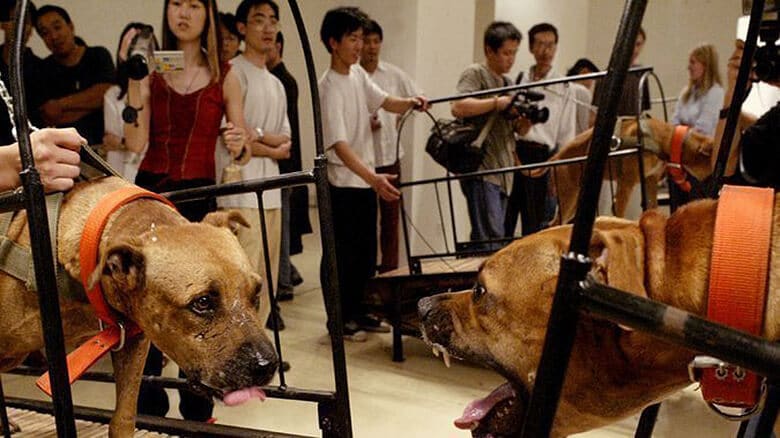Update: The Guggenheim just released the following statement:Out of concern for the safety of its staff, visitors, and participating artists, the Solomon R. Guggenheim Museum has decided against showing the art works Dogs That Cannot Touch Each Other (2003), Theater of the World (1993), and A Case Study of Transference (1994) in its upcoming exhibition Art and China after 1989: Theater of the World.
When is art that depicts abuse art, and when is it simply torture? That’s the question at the center of a protest aimed at a Guggenheim Museum exhibit slated to open the first week of October in New York City and ends in the beginning of January. Called “Art and China after 1989: Theater of the World,” many believe some of the works are animal abuse.
The video at the heart of the issue, “Dogs That Cannot Touch Each Other,” is a seven-minute film in which pit bulls covered with scars face each other, tethered on treadmills, a tool typically used to train dogs to fight. Forced to run at a high speed, the dogs lunge at each other, but cannot reach. As they continue running in place, the dogs become increasingly exhausted, their muscles straining and their mouths foaming.
Created in 2003 by Chinese artists Sun Yuan and Peng Yu, the video began as a live performance with the dogs “installed” on treadmills in a museum in Beijing.
Related: One L.A. Comic Is Standing Up for Pit Bulls, Both On and Off the Stage
“We recognize that the work may be upsetting,” the museum said in a statement. “The curators of the exhibition hope that viewers will consider why the artists produced it and what they may be saying about the social conditions of globalization and the complex nature of the world we share.” (We asked staff at Guggenheim to answer follow up questions but they have not responded at the time of publication.)
Many aren’t buying it, including the nearly 470,000 who have currently signed a petition asking the museum to pull the exhibit.
“I would expect a prestigious institution like the Guggenheim Museum to stand against cruelty,” says Sophie Gamand, the photographer known for her pit bull series Pit Bull Flower Power. “They had a choice in what to show for this exhibit, yet selected several pieces that display utter cruelty, including the now infamous dog video.”
There are other exhibits that step over the line into animal abuse. “A Case Study of Transference” consists of two live pigs, their backs stamped with Roman and Greek letters but is actually stylized, meaningless English. In all of the images, one pig is mounting the other. The Guggenheim is including a video of the live “installation.”
There is also the signature piece “Theater of the World” created by artist Huang Yong Ping in 1993. The exhibit will show live creatures – including centipedes, cockroaches, crickets and geckos — enclosed in a glass dome for people to view. During its three-month run time, some of the animals will die from natural causes, while others will be eaten. New York pet shops plan on bringing in more creatures to restock the exhibit. It is supposed to symbolize the ever-changing world of China, according to The New York Times.
“Art has a long history of blurring the definitions of what’s ethical and what’s legal, and it should,” says Gamand, who started a social media protest #TortureIsNotArt and #GuggenheimTortureIsNotArt. “But the line should also be very clear when it comes to the actual torture of living, breathing creatures to achieve an artist’s vision and the staging of acts of cruelty for entertainment.”
Matt Bershadker, president and CEO of the ASPCA, released his own statement, telling This Dog’s Life:
“We fully support artistic expression, but strongly oppose any use of animals in art or entertainment if it results in pain or distress to the animals,” he says. “At a time when society’s animal welfare values are evolving and moving forward in many ways – in both communities and in our laws – engaging in animal cruelty and putting it on public display like this moves us backward, regardless of artistic intent.”
He added, “The Guggenheim Museum has rejected objectionable live animal content in the past, and should have rejected these reprehensible and truly harmful representations as well,” he says. “It is not a question of what qualifies as ‘art.’ It’s an understanding that animal cruelty is as unacceptable in art as it is in life.”
The Guggenheim received a $300,000 grant to exhibit “Art and China After 1989.” It currently has $175 million in assets.
Related: Abused Bonnet-Wearing Pit Bull Finally Finds Her Forever Home



















